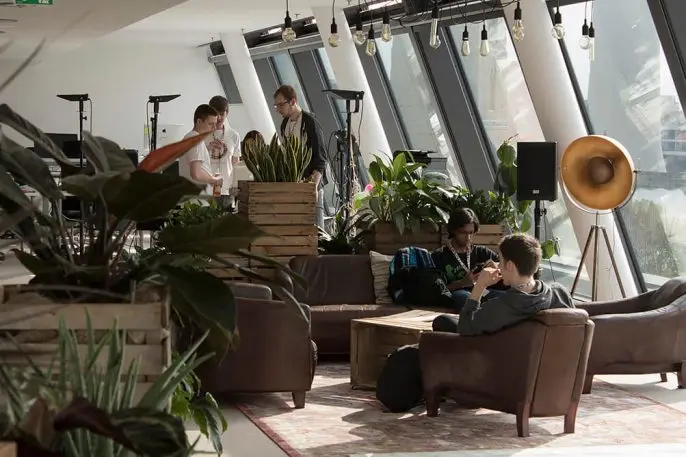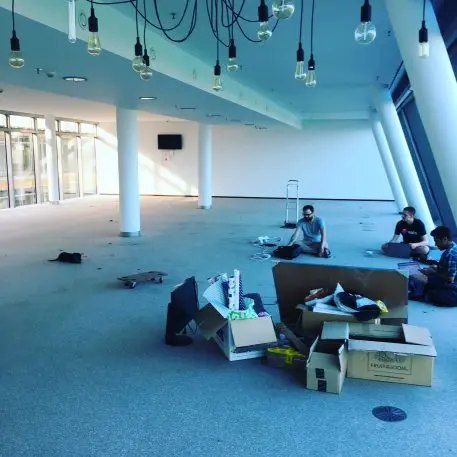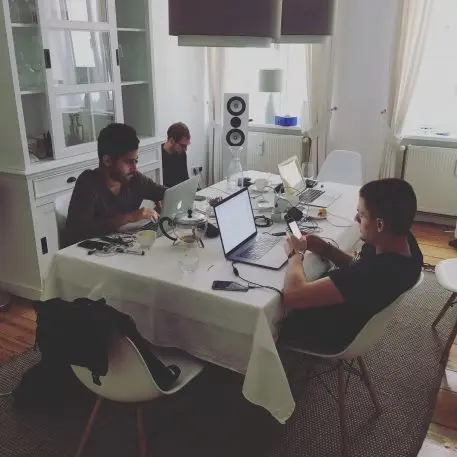You may have heard of Dubsmash, thanks to our early viral success and millions of downloads—the kind of startup fairytale many app company founders such as ourselves dream of. But the real story of Dubsmash is a strange one. While the story has plenty of good moments, like appearing on magazine covers and breaking app store records, there was also a wicked and surprising twist: We had to do something most startups never dream of. In the middle of what looked like a moment of huge success, we realized we had to tear our company down. If we hadn’t, it wouldn’t have had a future at all.
Let’s rewind to Berlin in 2014, when social media apps were already the next big thing. We had a great idea: Build a really fun app where users lip sync to songs or short clips from movies and share the often very funny clips on social media. Our idea worked. After quickly becoming the top downloaded app in Germany, Dubsmash accelerated into a global hit, with 50 million downloads in six months.
As our user numbers grew, our company grew too. We raised capital, we hired more team members, planned the future of the app, and added features we thought users would like.

https://www.youtube.com/watch?v=WPr109ETJ6o
Rapid, viral growth like this is what most app makers dream of. Conventional startup wisdom says that if you’re growing this fast and getting global attention, that means you’re on your way to building a successful business.
But as we looked out of the window at rainy Berlin, and inward at the team that had grown to over 50 people, we had a dreadful realization. The numbers weren’t telling the whole story. The stats were lying.
They looked great, if you looked at headline metrics like user growth—a metric that many people look at to measure an app’s success, and exactly the kind of metric Silicon Valley can get a little too focused on. Big growth numbers look sensational on term sheets and in blog headlines. But underneath those big numbers things had started to go wrong. Those million new users of Dubsmash who arrived after Neymar’s video? Some were there the next day, sure, but far fewer of them. We were getting new users, often attracted by celebrity Dubsmash moments, but after these users had made a video or two or watched a handful of the better-known Dubsmash clips, they tended to stop using the app.
User retention numbers just weren’t keeping pace with user growth, which was clearly bad in the long term, despite the exciting user growth metrics. If you can’t keep a user on your platform, then you don’t have a product market fit—or a business.
Worst of all, we didn’t know how to turn the app around.
Back to bare bones
The veil of viral success is thin, and peeking through it we could see some big shadows looming. The user retention numbers and the finances were going to collide. We had to decide what to do to banish those shadows. First, we decided to iterate. Each cycle, we added in features. The retention continued to slide and questions remained: Should we keep adding extra features to the app? Should we be more like a social network, or less?
None of it worked, and we felt stuck inside the trappings of success, knowing that the fast growth of the company was unsustainable. We questioned everything: Should we transform into something new? Should we become a B2B-style enterprise? Did we want to pivot, as many others had done before?
We realized we were in the middle of what entrepreneur Scott Belsky calls the “messy middle”—the time after you’ve started a business when you’re faced with seemingly insurmountable obstacles.
In the end, we did something few startups you’ve ever read about will do.

It was painful and confusing. In a moment when it looked like we should be surging ahead, it felt like we were going backward.
When it was all done, we were back in the basement. Just a handful of us, working at a simple table and wrestling with painfully slow home internet while we tried to work out what to do next.
Then we decided to move the company across the ocean to New York.
Though Berlin was jam-packed with smart, eager young engineers, we thought New York might give us a taste of American entrepreneurial thinking, as well as potential investors and engineers. In New York, where everyone strides down the sidewalk like they know exactly where they are going, we hoped there would be the right atmosphere, the right people to work with, and perhaps the right money to turn our viral app’s flash in the pan success into a steady burning fire.
Dubsmash was physically torn in two. Suchit moved first, and worked solo in a tiny coworking space six time zones away from the small team left in Berlin. He stayed motivated by the dedication of the Berlin team, which was still working hard to support the users Dubsmash still had, while trying to figure out how to improve it.

We still were not sure how to push our user retention numbers higher, and we knew we had a lot of work ahead of us: We had to hire a whole new product and engineering team, deal with the day-to-day difficulties of running a startup and rethink. Then, we had to take the Dubsmash app apart and rebuild it, better.
Letting go of our employees in Berlin was difficult—we’d worked hard to find the right folks, but now there was a chance to build a wholly new team of engineers and product specialists, learning lessons from the last time we went through the process. We believe in great people, and we think that it’s through a great team and a great process that, ultimately, you build a great product. After interviewing hundreds of people, we found some great folks in the product and engineering sphere in New York and talented folks to help us on the community side. We were ready to build something new again.
From an engineering point of view it was almost a relief to have the opportunity to start with a clean sheet app, no matter how the app was going to work going forward. Iterating and iterating an application like Dubsmash had resulted in many extras that had been glued on to the core over time. The iterations themselves weren’t bad, and we’d added some critical features to over time that really improved things, but rethinking gave us the chance to hand-pick the best pieces from the iterative cycle—the bits we knew helped rather than hindered users—and build them carefully into a new version of the app.
Refocusing and rebuilding
At its core, Dubsmash is based on the quality content made by the very keenest few, combined with more fun or surprising content from other users—and that gave us an idea about the right way to rebuild the app and the company.
We realized that we didn’t need to radically transform Dubsmash. We were going to stay close to our original idea, but we were going to pay attention to the people who make our app work: the users.
In our user research, we discovered there was a small community of young minority teens who sought to share dance moves on Instagram they had invented. Sometimes they used music they had written themselves.

We also raised a secret round of funding during summer 2019 and brought back our incredible partner through this journey, Danny Rimer from Index Ventures. He believed in us through all of the craziness and was exactly what you hoped for in any partner—supportive when needed but direct and firm when necessary. We also brought on a new investor: General Catalyst, with formidable partner Niko Bonatsos, who is best known for discovering Snapchat.
After our challenges and our unusual rebirth, we think we’re maybe 1% of the way on our journey. There is still a long way to go.
It is exciting to be working on something that finally really works.
Suchit Dash, Jonas Druppel, and Tim Specht are the founders of Dubsmash.
Recognize your brand’s excellence by applying to this year’s Brands That Matter Awards before the early-rate deadline, May 3.
